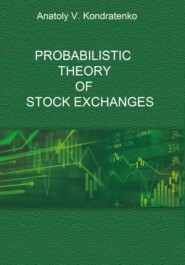По всем вопросам обращайтесь на: info@litportal.ru
(©) 2003-2025.
✖
Probabilistic Economic Theory
Настройки чтения
Размер шрифта
Высота строк
Поля
We assume that, from one side, these five general principles are capable of sufficiently and adequately describing the basic structural and dynamic properties of market economic systems and the market processes within them. From other side, they can be regarded as the basic pillars of physical economics, which carry on constructing step-by-step the bodies or frameworks of our physical economic models. These principles and their substantiation will be repeatedly discussed in more detail and step-by-step in this book. Concluding, let us stress that new probabilistic economic theory has been built on the basis of these principles in this book.
4. The Classical Economies
4.1. The Two-Agent Market Economies
As mentioned previously, below we will sequentially introduce into the theory the new concepts of physical modeling. They will be the building blocks in the construction of the body or framework of our models, which will also be filled step-by-step with new, concrete contents. We will start with the construction of the simplest physical economic models. In this paragraph we will create this with the use of analogies and formal methods of classical mechanics. These physical economic models will be referred to as the classical economies. Naturally in construction, we will use only first four principles, since only they have analogues in classical mechanics.
As we know, market agents are the buyers and sellers of goods and commodities, and as such are the major players in the market economy. They strongly interact with each other and with the institutions and the market’s external environment including other market economies. They continuously make decisions concerning the prices and quantities of good, and buy or sell those in the market. All the market agents’ actions govern the outcome of the market, which is the essence of the agent principle. We believe the agents to behave to a certain extent in a deterministic way, striving to achieve their definite market goals. This means that the behavior of market agents is, in turn, governed by the strict the economic laws in the market. The fact that these laws have until now been of a descriptive nature in classical economic theory, and they have not yet been expressed in a precise mathematic language, is not of key importance in this case. What is really important is that we believe all the market agents to act according to the economic laws of social cooperation that can be approximately described with the help of the market-based trade maximization principle.
Every market agent acts in the market in accordance with the rule of obtaining maximum profit, benefit, or some other criterion of optimality. In this respect, we believe the many-agent market economic systems to resemble the physical many-particle systems where all the particles interact and move in physical space. This is also in accordance with the same system-based maximization principle, such as the least action principle in classical mechanics which is applied to the whole physical system under study. The analogous situation exists in quantum mechanics (see below in the Part F).
The main drive of our research was to take the opportunity to create dynamic physical models for market economic systems. We construct these physical economic models by analogy with physics, or more precisely by analogy with theoretical models of the physical systems, consisting of formal interacting particles in formal external fields or external environments [1]. Let us stress that these particles are fictitious; they do not really exist in nature. Therefore, the physical systems mentioned above are also fictitious and they do not exist in nature either. They are indeed only imagined constructions and served simply as patterns for constructing the physical economic models. Thus, these physical economic models consist of the economic subsystem, or simply the economy or the market. It contains a certain number of buyers and sellers, as well as its institutional and external environment with certain interactions between market agents, and between the market agents and the market institutional and external environment. Moreover, according to the dynamic and evolutionary principle we assume that equations of motion, derived in physics for physical systems in the physical space, can be creatively used to construct approximate equations of motion for the corresponding physical models of economic systems in the particular formal economic spaces.
Let us briefly give the following reasons to substantiate such an ab initio approach for the one-good, one-buyer, and one-seller market economy. Let price functions p
(t) and p
(t) designate desired good prices of the buyer and seller, respectively, set out by the agents during the negotiations between them at a certain moment in time t. Analogously, by means of the quantity functions q
(t) and q
(t) we will designate the desired good quantities set out by the buyer and the seller during the negotiations in the market. Below, for brevity, we will refer to these desired values as the price and quantity quotations, which can or cannot be publicly declared by the buyer and the seller, depending on the established rules of work on the market. Note that the setting out of these quotations by the market agents is the essence of the most important market phenomenon in classical economic theory, namely the market process leading eventually to the concrete acts of choices of the market agents, being implemented by the buyer and seller through making deals (see below). Graphically, we can display these quotations as the agents’ trajectories of motion in the formal economic space as will be shown below. In real market life, these quotations are discrete functions of time, but, for simplicity, we will visualize them graphically (as well as supply and demand functions, see below) as continuous linear functions or straight lines. This approximate procedure does not lead to a loss of generality, since these functions and lines are necessary to us. They are only for the illustration of the mechanism of the market work and for the most general graphic representation of the motion of the market agents in the two formal economic spaces, corresponding to the two independent variables, price P and quantity Q. We will refer to this agent motion as market behavior, for brevity, and sometimes the evolution of the economy in time. All these terms are, in essence, synonyms in this context of the discussion. And for simplicity we will call these spaces the price space and the quantity space, respectively, as well as the united space as the price-quantity space.
By setting out desired prices and quantities this way, buyers and sellers take part in the market process and act as homo negotians (a negotiating man) in the physical modeling, aiming to maximum satisfaction in their attempts to make a profit on the market. This is the first market equilibrium price p
and quantity q
at a moment in time t
at which the agents’ trajectories intersect, the deal takes place, and the interests of both the buyer and seller are optimally satisfied, taking inexplicitly into consideration the influence of the external environmental and institutional factors on the market in general. It is here that one can see similarity in the movement of the many-agent economic system in the price-quantity economic space (described by the buyer’s trajectories p
(t), q
(t) and seller’s trajectories p
(t), q
(t)) to the movement of the corresponding many-particle physical system in the physical space (described by the particles’ trajectories x
(t)) which is also subject to a certain physical principle of maximization. In Fig. 1, we give the graphic representation of these trajectories of agents’ motion depending on the time with the help of the suitable coordinate systems of the time-price (t, P), and the time-quantity (t, Q), in the same manner as we do the construction of analogous particles’ trajectories in classical mechanics. Below we will demonstrate a substantial similarity with physics that is depicted in the upper part of Fig. 1, with, the trajectory of the motion of agents in the price space (P-space below) and, in the lower part of Fig. 1 – in the quantity space (Q-space below). In the aggregate, both pictures represent the motion of market agents in the price quantity space (PQ-space below).
This agents’ motion reflects the market process, which consists in changing continuously by the market agents their quotations. Note, we depicted in Fig. 1 a certain standard situation on the market, in which the buyer and the seller encountered deliberately at the moment of the time t
and began to discuss the potential transaction by a mutual exchange of information about their conditions, first of all the desired prices and the desired quantities of goods. During the negotiation, they continuously change these quotations until they agree on the final conditions of price p
and quantity q
, at the moment in time t
. Such a simplest market model is applicable, for example, for the imaginable island economy in which once a year, a trade of grain occurs between a farmer and a hunter. They use the American dollar, $. To illustrate, the situation is described below in Fig. 1. Note that in this and subsequent pictures we use arrows to indicate the direction of the agent’s motion during the market process.
Up to the moment of t
, the market has been in the simple state of rest, there were no trading in it at all. At the moment of the time t
, there appear the buyer and the seller of grain in it, which set out their initial desired prices and quantities of grain, p
(t
), p
(t
), and q
(t
), q
(t
). Points P and V in the graphs show the position of the buyer (purchaser) and seller (vendor) at the given instant of t
. It is natural that the desires of buyer and seller do not immediately coincide, buyer wants low price, but the seller strives for the higher price. However, both desires and needs for reaching understanding and completing transaction remain, otherwise the farmer and the hunter will have the difficult next year. The process of negotiations goes on, the market process of changing by the agents their quotations continues. As a result, the positions of the market agents converge and, after all, they coincide at the moment in time of t
, which corresponds to the trajectories’ intersection point E1 on the graphs.
Fig. 1. Trajectory diagram displaying dynamics of the classical two-agent market economy in the one-dimensional economic price space (above) and in the economic quantity space (below). Dimension of time t is year, dimension of the price independent variable P is $/ton, and dimension of the quantity independent variable Q is ton.
A voluntary transaction is accomplished to the mutual satisfaction. Further, the market again is immersed into the state of rest until the next harvest and its display to sale next year at the moment in time of t
. Harvest in this season grew, therefore q
(t
)> q
(t
). In this situation, the seller is, obviously, forced to immediately set out the lower starting price, p
(t
)< p
(t
), while the buyer, seizing the opportunity, also reduced their price and increased their quantity of grain: p







